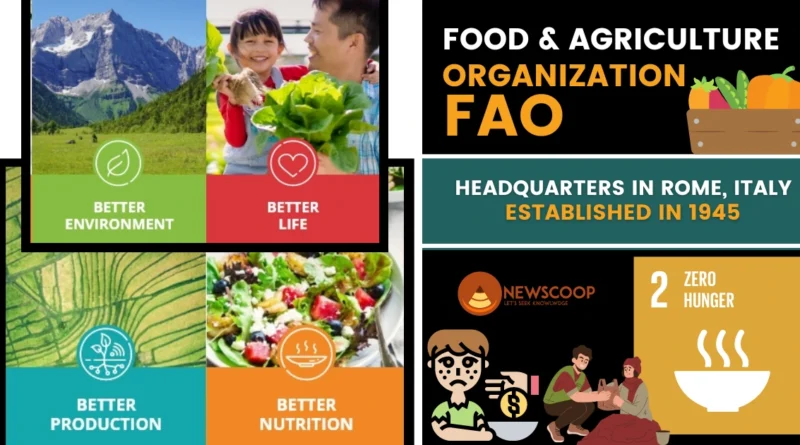Food & Agriculture Organization (FAO): Complete Notes
The Food and Agriculture Organization (FAO) is a specialized agency of the United Nations that plays a crucial role in promoting global food security, reducing hunger, and ensuring sustainable agricultural practices. With a mandate to address global food challenges, FAO works towards eradicating hunger, improving nutrition, and fostering sustainable agricultural development.
This article explores the significance of FAO in the context of UPSC (Union Public Service Commission) examinations, highlighting its objectives, functions, and key initiatives.
What is Food & Agriculture Organization (FAO)?
The Food and Agriculture Organization (FAO) is a specialized agency of the United Nations that was founded in 1945. Its primary goal is to achieve food security for all and make sure that people have access to sufficient, safe, and nutritious food. Further, FAO works towards eliminating hunger, improving nutrition, promoting sustainable agricultural practices, and fostering the development of rural areas.
Moreover, it operates as a neutral forum for governments, NGOs, and other stakeholders to come together, share knowledge, and coordinate efforts to address food and agricultural challenges globally.
Objectives of FAO

The following are the key objectives of FAO:
- Eradicating hunger and malnutrition
- Improving nutrition outcomes
- Promoting sustainable agriculture
- Supporting rural development
- Enhancing resilience and adaptation to shocks and stresses.
Background & Formation
The FAO’s origins can be traced to the United Nations Conference on Food and Agriculture held in Hot Springs, Virginia, in 1943. The conference aimed to address the devastating impact of the war on food production, distribution, and nutrition. It brought together representatives from various countries to discuss strategies for ensuring food security and fostering agricultural development in the post-war era.
The Food and Agriculture Organization (FAO) was indeed established on October 16, 1945, during a United Nations summit held in Québec City, Canada. The conference brought together representatives from 44 countries to address the food and agricultural challenges faced in the aftermath of World War II.
Headquarters of FAO
The Food and Agriculture Organization (FAO) is based in Rome, Italy. It started in 1945 and now has offices in more than 130 countries worldwide. The headquarters is in the center of Rome, close to famous sites like the Circus Maximus and the Colosseum.
Important Publications
Here is a list of some major publications by the Food and Agriculture Organization (FAO):
- The State of Food and Agriculture (SOFA)
- The State of World Fisheries and Aquaculture (SOFIA)
- The State of the World’s Forests (SOFO)
- The State of the World’s Land and Water Resources (SOLAW)
- The State of Food Security and Nutrition in the World (SOFI)
- FAO Statistical Yearbook
Also Read: United Nations Human Right Council (UNHRC)
Initiatives of the Food and Agriculture Organization (FAO)
Food and Agriculture Organization (FAO) initiatives aim to address key challenges in food and agriculture. Some notable initiatives include:
- Zero Hunger Initiative
- Climate-Smart Agriculture
- Global Soil Partnership
- Blue Growth Initiative
- Hand-In-Hand Initiative
- Save Food Initiative
- Agricultural Emergency Response
- Farmer Field Schools
Zero Hunger Initiative: FAO’s global effort to eliminate hunger and malnutrition by 2030. It focuses on sustainable agriculture, improving nutrition, and supporting small-scale farmers.
Climate-Smart Agriculture: Promoting practices that help farmers adapt to and mitigate climate change impacts. This includes soil health improvement, water resource conservation, and reduced greenhouse gas emissions.
Global Soil Partnership: Collaborative efforts to enhance soil management for food security and sustainable development. It emphasizes sustainable practices, improved data and monitoring, and raising awareness about soil health.
Blue Growth Initiative: Promoting sustainable fisheries and aquaculture practices for economic development and food security while ensuring marine and freshwater ecosystem conservation.
Hand-In-Hand Initiative: Partnership-based approach for rural development, empowering small-scale farmers, improving access to finance and markets, and creating rural employment opportunities.
Save Food Initiative: Aims to reduce food loss and waste throughout the food supply chain. It promotes efficient storage, processing, and distribution methods to minimize food loss and enhance food security.
Agricultural Emergency Response: FAO provides rapid assistance during crises, such as natural disasters and conflicts, to help affected communities recover and rebuild their agricultural systems.
Farmer Field Schools: FAO facilitates Farmer Field Schools, which are community-based training programs that empower farmers with knowledge and skills for sustainable agriculture practices, pest management, and climate resilience.

Functions of FAO
The main functions of the Food and Agriculture Organization (FAO) include:
- Providing policy advice on agricultural and rural development.
- Collecting and analyzing data on food and agriculture.
- Offering technical assistance and capacity building.
- Responding to food and agriculture emergencies and crises.
- Collaborating with partners and fostering partnerships.
- Developing international standards and guidelines.
- Advocating for sustainable agriculture and food security.
FAO Strategic Framework 2022-2031
The FAO Strategic Framework 2022-2031 is a guiding document that outlines FAO’s vision and strategic priorities for the next decade. It aims to support the implementation of the 2030 Agenda for Sustainable Development by transforming agri-food systems to be more efficient, inclusive, resilient, and sustainable.
Vision for a Sustainable and Food-Secure Future: In line with the Agenda 2030 for Sustainable Development, the FAO Strategic Framework articulates FAO’s vision of a sustainable and food-secure future for everyone. It underscores the importance of addressing global challenges in agriculture and food systems to ensure a prosperous and equitable world.
A Ten to Fifteen-Year Framework: Since 2010, FAO has adopted a ten to fifteen-year Strategic Framework that guides its activities. The frameworks are revisited every four years to align with evolving global and regional issues and to ensure the relevance and effectiveness of FAO’s work.
Responding to Global Challenges: The FAO Strategic Framework 2022-2031 was developed in response to key global and regional issues within FAO’s mandate areas, including the profound impact of the COVID-19 pandemic. It recognizes the need to adapt and strengthen agricultural systems to meet the challenges of a changing world.
An Open and Transparent Process: The development of the FAO Strategic Framework 2022-2031 followed an open and transparent process. It involved internal and external discussions, engagement with the Governing Body, and informal consultations. This inclusive approach ensured that the framework reflects the needs and priorities of member countries and stakeholders.
Strategic Priorities: The FAO Strategic Framework 2022-2031 sets out strategic priorities and actions to guide FAO’s work in the coming years. It focuses on transforming agri-food systems to be more sustainable, resilient, and inclusive. The framework aims to enhance efficiency, promote inclusivity, build resilience, and ensure the sustainability of food and agriculture.
Contributing to the Sustainable Development Goals: Aligned with the Sustainable Development Goals (SDGs), the FAO Strategic Framework 2022-2031 plays a crucial role in FAO’s contribution to the global development agenda. It serves as a roadmap for FAO’s efforts in achieving the SDGs, particularly those related to eradicating hunger, promoting sustainable agriculture, and ensuring food security.
India & FAO
FAO’s collaboration with India has been beneficial since its establishment in 1945. The FAO began its activities in India in 1948 and maintains a presence in New Delhi, with the Ministry of Agriculture serving as its main ministry.
Influence on India’s Agriculture Sector: The goals outlined in India’s NITI Aayog’s National Development Agenda, Three Year Action Agenda, and Union Budget provide the overall framework for the agriculture sector, in which the FAO plays an important role. The organization contributes to India’s achievements in agriculture, livestock, fisheries, food security, and natural resource management.
Dr. Binay Ranjan Sen’s Contribution: Notably, Dr. Binay Ranjan Sen, an Indian civil servant, served as the FAO’s Director General from 1956 to 1967. During his tenure, the World Food Programme was established, which received the Nobel Peace Prize in 2020, showcasing India’s contributions to global food security efforts.
India’s Initiatives: The FAO has also recognized and supported India’s initiatives, such as the International Year of Pulses in 2016 and the upcoming International Year of Millets in 2023. These initiatives highlight India’s focus on promoting sustainable farming practices and diversifying food sources.
Celebrating 75th Anniversary: In 2020, the FAO celebrated its 75th anniversary on October 16th. To mark this occasion, India issued a commemorative coin with a face value of Rs 75, demonstrating recognition and appreciation for FAO’s contributions to agriculture and food security.
Overall, the collaboration between FAO and India has been significant, with the organization playing a vital role in supporting India’s agricultural development and food security efforts.
Conclusion
In conclusion, the Food and Agriculture Organization (FAO) is a vital organization within the United Nations system that focuses on addressing global food challenges. Through its coordination, research, technical assistance, data collection, and education programs, FAO aims to improve agriculture, forestry, fisheries, and land and water resources.
By working towards eradicating hunger, improving nutrition, and promoting sustainable agricultural practices, FAO plays a critical role in ensuring food security and sustainable development for the benefit of current and future generations.
Thank You!

